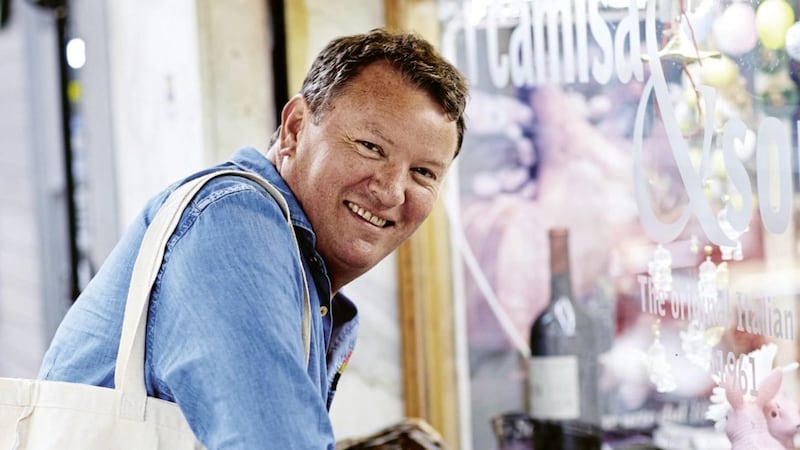WITH pizza, pasta and cheese galore, it’s hard not to like Italian food. But few people love it quite as much as chef Theo Randall.
Randall – who runs Theo Randall at the InterContinental in London – admits to having a “lifelong obsession with Italian food”. It stemmed from childhood holidays there, and an artist mother who was “mad about Italian”, he says. “When we were kids, we grew up on her cooking from lots of Italian cookbooks.”
The London-born chef gets almost misty-eyed when talking about past meals in Italy – particularly the first time he tasted spaghetti alle vongole (spaghetti with clams).
He has a particular obsession with the Italian deli, confessing he’s “an obsessive shopper – I will go to a particular shop to buy one item, and I’ll probably buy three different jars of passata”, who often comes home laden with anchovies, olive oil and as much cured meat as he can carry.
“I would say I haven’t got an Italian bone in my body but I have an Italian soul,” Randall muses – and he suggests we could all learn a lot about the country’s approach to food.
“It’s about keeping things really simple and not overeating,” he explains. “Less is more – sometimes a really delicious plate of pasta is all you need, or maybe it’s a baked dish or a risotto – if that’s done really, really well, it doesn’t have to have 25 ingredients in it. It could just be courgettes, butter, Parmesan and some fresh basil.”
Randall champions the Italian way of “frugal cooking” too. “It’s making use of what you’ve got, rather than going out and buying things that are completely out of season, or making things too elaborate,” he explains.
“I think we’re quite wasteful in lots of ways: people go to the supermarket, they’ll do their shop and buy lots and lots of stuff. They’ll put it in the fridge, it’ll be in some sort of cellophane wrap, and about four or five days later, they realise they bought this asparagus and it’s gone off, so they just throw it away.”
When it comes to Italian food, the biggest mistake we could be making is usually with pasta. “I think this is where we go wrong: we cook so much pasta that you end up having this huge bowl of pasta and you sit in front of the TV, then you go back for a second portion, and then about 20 minutes later you’re lying on the sofa thinking, ‘Oh my God, my stomach is about to explode because I’ve eaten so much carbohydrates’,” Randall says with a moan.
This is incredibly easy to do, particularly as most of us can whip up a pan of pasta with our eyes closed – and that’s exactly what Randall wants us to avoid.
“We do things automatically, we become like robots and cook things and we have our own ways of doing things,” he says. “I think we need to open our eyes and look at Italian produce, and see what’s out there and what’s available.”
The chef thinks we should all be chasing that feeling of “having something where you’re literally licking the bowl and thinking, ‘God, I wish I cooked more’, but 10 minutes later you’re actually fine, because you’ve digested”, he says.
Good quality ingredients can help you get this feeling, which is why Randall has written a cookbook dedicated to the Italian deli. “I think food has a personality, it’s very important that there is a story behind some of these things,” he explains – and talking to experts in a deli can help uncover these stories and give genius tips for the kitchen. Little tweaks to classic meals can make a huge difference: Randall recommends cooking dried pasta two or three minutes less than the packet says, and adding some pasta water to the sauce for extra flavour.
Immersing yourself in Italian food beyond a bowl of pesto pasta could help you out of your lockdown cooking rut: as Randall says, it’s “very versatile, the kind of food you don’t really ever get bored of”.
Randall certainly hasn’t got bored of Italian food in lockdown, and it doesn’t look like he will any time soon. Anyone familiar with the cuisine will know it’s all about family; big bowls of pasta and trays of pizza to be shared with your loved ones.
:: The Italian Deli Cookbook by Theo Randall, photography by Lizzie Mayson, is published by Quadrille, priced £26. Below are two recipes from the book for you to try.
MELANZANE PARMIGIANA
(Serves 4)
4tbsp olive oil, plus extra for oiling
1 garlic clove, finely sliced
8 basil leaves
600g tomato passata
4 aubergines, half peeled to give stripes (to help the aubergine cook evenly)
3 organic eggs, beaten
200g tipo 00 flour
100ml sunflower oil
200g mozzarella, chopped
100g Parmesan, finely grated
Sea salt and freshly ground black pepper
Method:
Place a heavy-based saucepan over a medium heat. When hot, add three tablespoons of the olive oil and the garlic and fry for about 30 seconds, until the garlic is soft but has no colour. Add four of the basil leaves and cook for 30 seconds, then add the passata, reduce the heat and cook for about 15 minutes, until the sauce has reduced by half. Tear in the remaining basil and add the remaining olive oil. Season and set aside. Slice the aubergines into 1cm rounds. Transfer them to a colander and sprinkle with salt. Leave for 20 minutes to draw out the liquid, then pat the slices dry with kitchen paper.
Have ready the beaten eggs in one bowl and the flour in another. Heat the sunflower oil in a frying pan over a medium heat. Dip each aubergine slice into the egg to coat, then place in the flour, taking care to fully coat each slice. Shake off any excess flour then fry, in batches, for three minutes on each side until they are all cooked through and have a nice, golden colour. Place on kitchen paper to drain.
Preheat the oven to 180C/160C fan/Gas Mark 4. Lightly oil a baking dish with olive oil. Arrange a layer of cooked aubergines evenly in the bottom of the dish, spoon over one third of the tomato sauce, sprinkle over one third of the chopped mozzarella, and sprinkle over one third of the Parmesan. Repeat the layers twice more, finishing with the final layer of Parmesan. Bake the parmigiana for 35 minutes, or until the top is golden and crispy (give it up to another 10 minutes, if you need to).
PACCHERI WITH PRAWN, COURGETTE AND PARSLEY SAUCE
(Serves 4 as a starter)
350g paccheri
3tbsp olive oil
1 garlic clove, finely sliced
2 courgettes, cut into 1cm matchsticks
150g Datterini (baby plum) tomatoes, halved
1tbsp finely chopped flat-leaf parsley leaves
250g uncooked prawns, halved lengthways (frozen are fine)
75ml dry white wine
Sea salt and freshly ground black pepper
Method:
Bring a large pan of salted water to the boil. Add the paccheri and boil for two minutes less than the packet instructions, until very al dente. Meanwhile, make the sauce. Gently heat two tablespoons of the oil in a large non-stick frying pan on a medium heat. When hot, add the garlic and courgettes. Cook for three minutes to soften, then add the tomatoes, parsley and halved prawns. Season with salt and pepper, add the white wine and cook on a medium heat for about three minutes, until the liquid has reduced by half.
Once the pasta is ready, using a slotted spoon or small sieve, transfer it to the sauce. Add a ladleful of the pasta cooking water and cook for a further two minutes, until the sauce becomes syrupy. Add the final tablespoon of olive oil and check the seasoning. The pasta should have a lovely bite to it and it should be coated in the sauce. Serve in warmed pasta bowls.
TIRAMISU
(Serves 6)
100g caster sugar
4 organic eggs, separated
500g mascarpone
125ml cold, strong black coffee
50ml sweet Marsala
300g savoiardi biscuits
50g unsweetened cocoa powder
Method:
Add the sugar and egg yolks to the bowl of a stand mixer and beat on a medium speed for about four minutes, until the mixture is pale. Add the mascarpone and beat for a further three minutes until light and fluffy.
In another bowl, whisk the egg whites until stiff, then fold them into the mascarpone mixture until fully combined, light and creamy.
Combine the coffee and Marsala in a shallow dish. One by one, dip one third of the savoiardi biscuits into the liquid and use them to line the bottom of a medium-sized, deep serving dish. Using a spatula, spread one third of the mascarpone mixture on top to create an even layer. Repeat this layering process twice more. Sift over the cocoa powder and refrigerate for at least three hours before serving.


